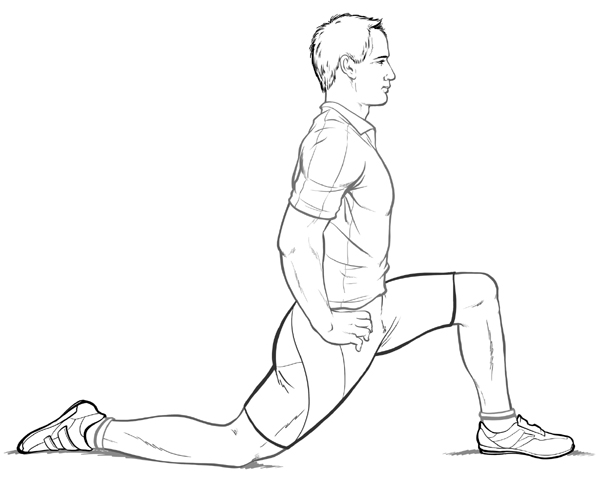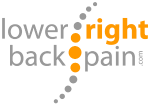Hyper Lordosis is too much sitting and excess body-fat. Weak abs and too much sitting puts your pelvis permanently forward. Similarly a large “beer belly” or excess stomach fat can tilt the pelvis forward.
Kneeling Hip-Flexor Stretch:
Kneel on left knee, with toes (or laces) down (use a towel to cushion as necessary), and place right foot flat on the floor in front of you, bend your knee till it is over that front ankle. Keeping your head up and back straight, Press hips forward until you feel tension in the front of your left thigh. You can rest hands on right thigh or on your hips. You should feel the stretch in you back hip flexor. Move your front foot further forward to increase the stretch.

Tips: Imagine trying to pull (or drag) your bottom knee across the floor. This should accentuate the stretch and isolate the hip flexor. You can Extend arms overhead, with elbows close to head and palms facing each other, and slightly arch your back while keeping your chin parallel to the ground. Hold for at least 15 seconds, then stretch the other side.
You can also put your same side arm over your head to add as slightly different angle to the stretch.
Stretch and strengthen our Upper-body. As mentioned above Hyper-lordosis often leads to slouching, forward rounded shoulders. You need to work your shoulders back into prober posture through the use of stretching and strengthening. You will notice that your posture and flexibility can quickly improve if you're persistent. So be patient and cognizant of your posture.
Doorway Chest Stretch:
Stand in a doorway with your left arm out 90 degrees to your side (hand above your head) with your arm in an L shape (your forearm should be perpendicular to the upper arm, "taking an oath" position. Press the forearm and front part of the shoulder into the door frame, turn your head and torso away from the wall until you feel an adequate stretch, hold 15 seconds. Repeat on the other side. You can also use both arms at the same time as long and the door frame isn’t too wide.
Chest Expansion Stretch :
Stand up tall with your arms behind your back, clasp your hands together.
- Lift your chest while raising your arms slightly. You can also have someone raise your hands further or place your hands on a fixed surface and bend your knees for a deeper shoulder stretch.
- Don’t over arch your back, keep your shoulders relaxed and down. Stop if you experience any pain.
Overhead Shoulder Rotation (aka: Shoulder dislocation Exercises): Use a broom stick or resistance band and do daily shoulder exercises See example: (Start with 2 sets of 12 reps)
Rear Delt Raises:
Bend you knees and bend you back forward to a 45 degree angle. Be sure to keep your back straight. The palms of your hands should be facing your body. This will be your starting position. Weight can (and should) be used if you are comfortable with the exercise.
Keeping your torso forward and stationary, and the arms slightly bent at the elbows, lift your arms straight to the side until both arms are parallel to the floor(in line with your shoulders). Exhale on your way up. (Note: avoid swinging your body or head, also be sure to bring the arms out to the side, not back.)
Hold for about a second at the top then slowly return your hands to your side. Then Repeat.
Hamstring stretch:
We recommend stretching one leg at a time to ensure each leg is getting the proper stretch. You will notice that one leg is probably more flexible than the other.
- Sit on the ground with your back straight
- Put one left leg out straight in front of you.
- Bend your other leg and put your foot against your thigh (to remove tension).
- Breathe in
- Bend forward at the hip reaching for your toes, breathe out slowly as you stretch forward.
- Hold this stretch for at least 20 seconds.
- Switch legs and repeat.
Quad stretch:
- Stand up straight. For beginners make sure and stable yourself with one hand against a wall or rail.
- Reach down with one hand and grab the same side foot (bend your knees if you have difficulty reaching your foot then return to standing)and pull it towards your buttocks. Depending on your flexibility you may or may not be able to touch your foot to your butt. Listen to your body – its okay to be uncomfortable during the stretch but it shouldn’t be painful.
- Be sure to keep your hips/pelvis even and perpendicular to the ground
- Hold the position for 15 seconds. To increase the stretch, try to tighten the thigh muscle (or straighten the leg) without allowing your foot to move from your butt.
- Swap sides and repeat.
Cat Pose (yoga): Get down on all fours (hands and knees). The spine should be kept in a neutral position (Table pose). The arms should be directly underneath the shoulders, similarly, the knees should be under the hips at equal distance apart. Inhale, while holding the Table pose.
Exhale slowly, curving the spine upward towards the ceiling, tucking the tail bone down, and allowing the neck to relax, lower the crown of the head toward the floor (with the chin drawing toward your chest). The back (spine) should make the shape of an arch. Think of a mad “Halloween” cat.
